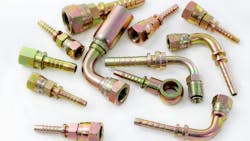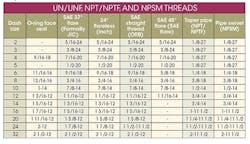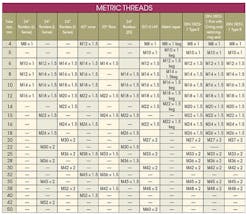How to Identify Threads on Hydraulic Fitting
This article was updated Jan. 17, 2023. It was originally published Oct. 21, 2004.
Using the correct thread is critical for proper mating and replacing hydraulic fittings. First and foremost, it is a safety issue. Correct assembly maintains pressure and reliably seals a fitting or adapter, making it safe for humans and equipment, not to mention the environment. It also prevents costly and time-wasting maintenance to cleanup and replace damaged parts.
READ MORE: 9 Early American Manufacturing Landmarks
Working engineers and designers, especially those in the fluid-power industry, are generally familiar with two groups of pipe threads: American pipe threads (NPT/NPTF, often referred to as SAE) and Unified threads (UN/UNF). But there seems to be an endless number of other unfamiliar threads, usually classified as "metric," regardless of their actual form. In reality, there are true metric threads as well as BSP (British Standard Pipe) threads.
For identification purposes, hydraulic tube fittings and connectors are separated into six thread types:
- UN/UNF
- NPT/NPTF
- BSPP (BSP, parallel)
- BSPT (BSP, tapered)
- Metric parallel
- Metric tapered
Three of these are parallel (UN/UNF, BSPP, metric parallel) and three are tapered (NPT/NPTF, BSPT, metric tapered). Three are pipe threads (NPT/NPTF, BSPT, BSPP) and three are not (UN/UNF, metric parallel, metric tapered).
Regardless of thread type, there are a few relatively simple steps engineers, designers, and technicians can us to properly identify threads being used on hydraulic fittings.
1. Determine if the thread is tapered or parallel. Sometimes all you have to do is examine them. Tapered threads get smaller in diameter toward the end of the fitting; parallel threads have the same diameter from end to end. If this is not obvious just by looking at the fitting, use the parallel jaws of a caliper, for example, to make a more exact comparison. An O-ring or tube nut can usually help show if threads are parallel.
READ MORE: The Basics of Threaded-Forming Fasteners for Plastics
2. Determine pitch. Pitch is defined in terms of threads per inch (TPI) or distance between threads. For metric threads, pitch is the distance between threads (mm). A pitch gauge is useful for comparing threads. Here’s a tip: It is easier to compare threads against a lighted background with a pitch gauge. Because some thread pitches are nearly identical, try several gauges before deciding on the one that work best. (Possible pitches are shown in the second column of the “How to Identify Threads” table.) Or you can revert to the simple but demanding process of measuring how many threads are in an inch.
3. Determine size. There are two methods for sizing threads: one for pipe threads and one for non-pipe threads. For pipe threads, determine nominal size by comparing the part against a size profile. A good rule of thumb for pipe sizes up to 2 in. nominal is to measure the OD and subtract ¼ in. Round off for the nominal pipe size. For non-pipe threads, measure the major diameter (OD) of the threads with a caliper.
4. Designate the thread. This final step is not part of the identification process; it’s a way to designate thread types in a standard format. Designations should indicate thread size (nominal or actual), type and, in some cases, pitch.
READ MORE: What's the Difference Between Thread-Forming and Thread-Cutting Tapping Screws?
Here are some other tips and little-known facts about threads.
- Standard thread diameters are no larger than their stated sizes. Gauged accurately, with a caliper for example, the measured diameter is normally slightly smaller than the actual thread size.
- Do not use these steps to identify Internal threads should not be because it is difficult to verify the pitch gauge’s fit on them. One way around this is to find the mating external thread and then determine its pitch.
- Tapered external threads will mate with parallel internal threads.
- NPSM threads are parallel but have the same pitch as NPT/NPTF. NPSM threads are typically used to hold swivel nuts together. The seal is the provided by contact between the 30-deg. internal chamfer on the male pipe thread and seating area inside the swivel.
Burleigh Bailey worked at Parker Hannifin Corp.’s Tube Fittings Div. when he authored the original article.



